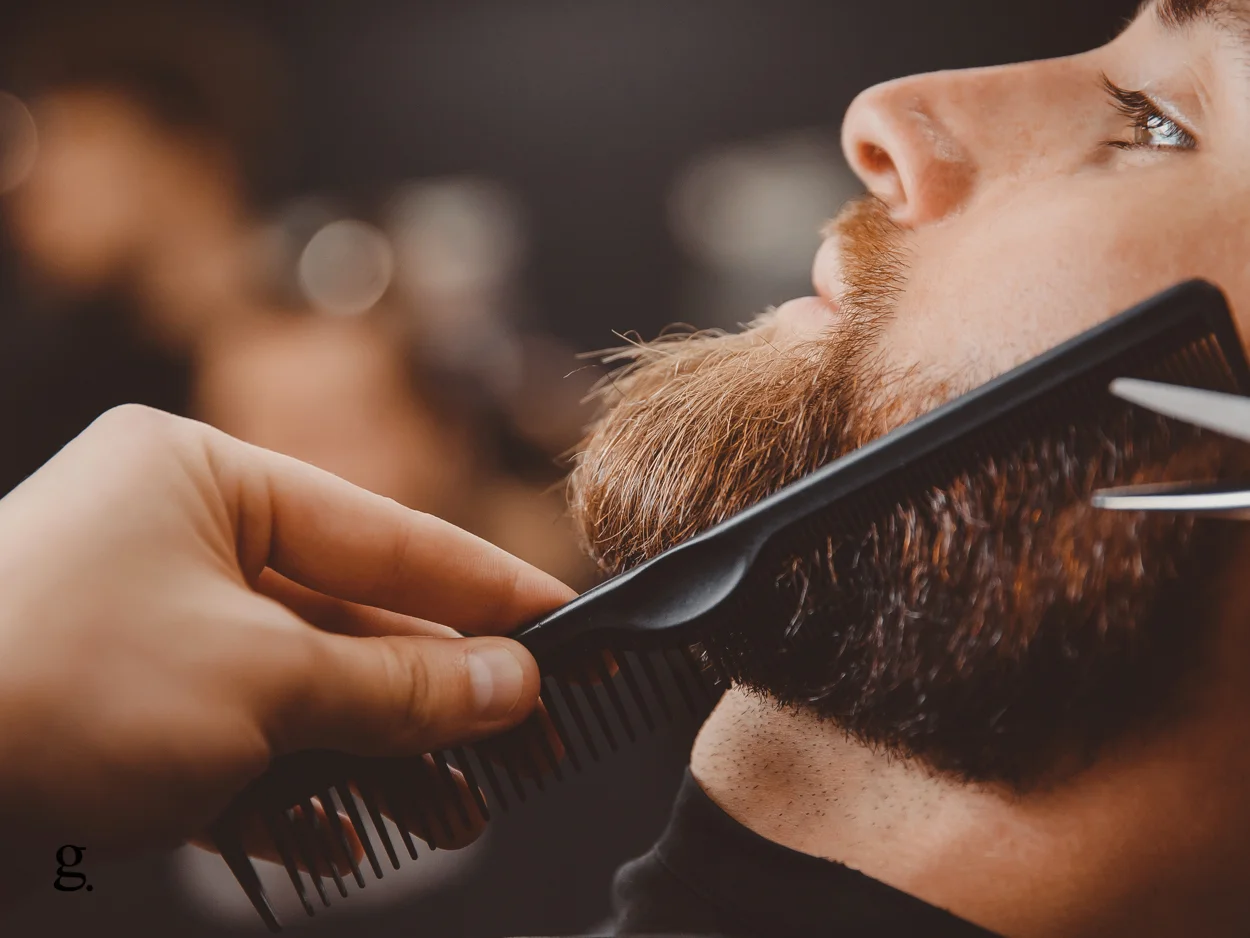Oh, beard dandruff! It’s one of those pesky little problems that can seriously cramp anyone’s style. When those tiny white flakes start making an appearance, it’s easy to feel a little self-conscious.
The Main Causes of Beard Dandruff
When it comes to beard dandruff, there are a few key culprits that might be causing those pesky flakes to rain down on your favorite shirt. Let’s take a closer look at the four main causes:
- Dry Skin: Just like the scalp, the skin beneath the beard can become dry and flaky. Factors such as harsh weather, over-washing, or using products with alcohol can strip the skin of its natural oils, leading to dryness and, you guessed it, dandruff.
- Seborrheic Dermatitis: This is a common skin condition that causes redness, itchiness, and flaking. It’s often triggered by stress, cold weather, or an overgrowth of yeast called Malassezia that naturally lives on our skin. When these factors are at play, seborrheic dermatitis can be the driving force behind those unwanted flakes.
- Improper Beard Care: Neglecting to properly groom and maintain your beard can result in a build-up of dead skin cells and excess oil. This combination can lead to—you guessed it—beard dandruff. So, remember to show your beard some love!
- Contact Dermatitis: Sometimes, your skin might not agree with certain products or ingredients. An allergic or irritant reaction can cause redness, itchiness, and flaking, making it look like you’ve got a case of beard dandruff on your hands (or, well, face).
Actionable Ways To Get Rid of Beard Dandruff
Now that we’ve covered the main causes of beard dandruff, let’s get down to business and explore how to tackle those flakes head-on. Here, we’ll share some top tips to help you get rid of beard dandruff and keep it at bay. Ready to say goodbye to those annoying little flakes? Let’s dive in!
1. Keep Your Beard Clean
A clean beard is a happy beard! To keep it pristine and dandruff-free, follow these steps:
- Choose the right shampoo: Opt for a gentle, sulfate-free beard shampoo that’s designed to cleanse without stripping your skin’s natural moisture. Regular hair shampoo might be too harsh for the delicate skin underneath your beard.
- Wash regularly, but not too often: Aim to wash your beard 2-3 times a week, depending on your activity level and skin type. Overwashing can dry out your skin, leading to more dandruff, while under-washing can cause oil and dead skin cell buildup.
- Use lukewarm water: Hot water can exacerbate dryness and irritation, so stick to lukewarm water when washing your beard.
- Pat dry gently: After washing, gently pat your beard dry with a clean towel to avoid tugging on the hair or irritating your skin.
2. Exfoliate Gently
To keep your skin healthy and dandruff at bay, incorporate a gentle exfoliating routine into your beard care regimen:
- Choose the right tool: Use a soft-bristled brush or a mild facial scrub specifically designed for beards. A brush can help dislodge dead skin cells, while a scrub can provide a deeper exfoliation.
- Exfoliate 1-2 times a week: Over-exfoliating can cause irritation, so stick to exfoliating once or twice a week, depending on your skin’s sensitivity.
- Be gentle: When using a scrub, apply it in gentle circular motions, avoiding harsh rubbing or scrubbing that can damage your skin or hair.
3. Moisturize, Moisturize, Moisturize
Hydration is key to keeping dandruff in check. Follow these moisturizing tips to keep your skin and beard happy:
- Choose the right product: Look for beard oils or balms with natural, nourishing ingredients like jojoba oil, argan oil, or shea butter. These ingredients not only lock in moisture but also soothe irritation and promote healthy hair growth.
- Apply daily: Use your chosen moisturizer daily, or more often if needed, to keep your skin and beard hydrated. A little goes a long way, so start with a small amount and adjust as needed.
- Massage it in: Gently massage the oil or balm into your beard and the skin beneath, ensuring even distribution and proper absorption.
4. Be Mindful of the Products You Use
Protect your skin and beard from irritation by being selective about your grooming products:
- Read the labels: Pay attention to the ingredients in the products you use on your beard and face. Avoid harsh chemicals, artificial fragrances, and alcohol, which can cause irritation and dryness.
- Test before using: Conduct a patch test on a small area of skin before applying new products to your beard or face. If you notice redness, itching, or irritation, discontinue use and try a different product.
- Simplify your routine: Stick to a few tried-and-true products that work for your skin and beard, rather than constantly switching things up or layering on too many products.
Reoccuring Beard Dandruff
Beard dandruff can be a persistent issue for some people, and there are several reasons why it might keep coming back despite your best efforts to eliminate it. Here are some common factors that can contribute to the recurrence of beard dandruff:
Inconsistent Grooming Routine
Neglecting a consistent and thorough grooming routine can lead to the buildup of dead skin cells, oil, and dirt in your beard, which can contribute to dandruff. Ensure you’re washing, exfoliating, and moisturizing your beard regularly to maintain a healthy environment for your skin and hair.
Using the Wrong Products
Using products that contain harsh chemicals, artificial fragrances, or alcohol can irritate your skin and cause or worsen dandruff. Always opt for gentle, natural, and hypoallergenic products designed specifically for beards to minimize irritation.
Underlying Skin Conditions
Sometimes, the cause of recurring beard dandruff may be an underlying skin condition, such as seborrheic dermatitis or contact dermatitis. If you’ve tried various treatments without success, it’s worth consulting a dermatologist to determine if an underlying condition is causing your dandruff to return.
Environmental Factors
External factors, such as dry weather, cold temperatures, or exposure to harsh elements, can cause your skin to become dry and irritated, leading to dandruff. Keep your beard protected and well-moisturized, especially during extreme weather conditions, to minimize dandruff flare-ups.
Stress and Diet
Stress and poor diet can have a negative impact on your skin’s health, potentially worsening dandruff. Prioritizing self-care, managing stress, and maintaining a balanced diet rich in essential nutrients can help improve your skin’s overall condition and keep dandruff at bay.
Fungal Overgrowth
Beard dandruff can sometimes be caused by a fungal infection. The most common fungus associated with dandruff is Malassezia, a type of yeast that naturally lives on our skin. In some cases, this fungus can overgrow and cause issues, including dandruff.
Malassezia feeds on the natural oils (sebum) produced by our skin. As it breaks down the oils, it produces oleic acid, which can irritate the skin for some people. This irritation may lead to an increase in skin cell production and shedding, resulting in dandruff-like flakes.
The Lowdown on Beard Cleansers
The skin on your face and underneath your beard is more sensitive than the scalp, so it’s crucial to opt for a gentle, hydrating facial cleanser or a cleanser specifically designed for beards.
A good beard cleanser should be mild and sulfate-free to avoid stripping the skin and hair of their natural oils. Look for cleansers that contain nourishing ingredients like aloe vera, chamomile, or glycerin, which can help soothe and moisturize the skin.
Using a cleanser specifically designed for beards or a gentle facial cleanser can effectively remove dirt, oil, and dead skin cells without causing irritation or dryness.
Things That Don’t Help Remove Beard Dandruff
While there are plenty of effective ways to combat beard dandruff, there are also some common misconceptions and practices that aren’t helpful or could even make the problem worse.
Let’s debunk some of these myths and clarify which habits to avoid when dealing with beard dandruff:
Using Regular Hair Shampoo
Hair shampoo is designed for the scalp and can be too harsh for the delicate skin beneath your beard. Using it on your beard may strip away natural oils, leading to dryness and irritation, which can exacerbate dandruff.
Over-Exfoliating
While gentle exfoliation is essential for removing dead skin cells and promoting healthy skin turnover, overdoing it can cause irritation and redness, making dandruff worse. Stick to exfoliating once or twice a week, and always be gentle with your skin.
Scratching
Scratching your beard might provide temporary relief from itchiness, but it can damage the skin, cause inflammation, and worsen dandruff. Resist the urge to scratch and focus on treating the underlying causes of your beard dandruff instead.
Relying on Home Remedies
While some home remedies may provide relief, not all are effective or suitable for everyone. It’s essential to research and consult a professional before trying any home remedies for beard dandruff, as some may cause further irritation or even harm your skin.
Conclusion
Dealing with beard dandruff can be frustrating, but understanding its causes and implementing effective strategies can help you keep those pesky flakes at bay. Remember to maintain a consistent grooming routine, choose gentle products designed for beards, and address any underlying skin conditions or fungal infections that may contribute to dandruff.
Don’t be discouraged if your beard dandruff doesn’t disappear overnight—it takes time and consistency to see improvements. If you’re still struggling with persistent dandruff despite your best efforts, don’t hesitate to consult a dermatologist or healthcare professional for personalized guidance and treatment.
By staying proactive and taking good care of your skin and beard, you’ll be on your way to enjoying a healthy, flake-free beard that looks and feels great.

